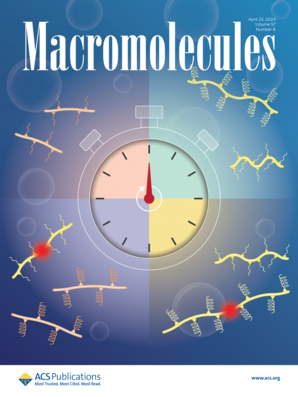新型全聚合物纳米复合材料能够通过自组装操纵机械性能
IF 5.1
1区 化学
Q1 POLYMER SCIENCE
引用次数: 0
摘要
具有不同微观结构的聚合物纳米复合材料(pnc)的机械性能定制方法仍然有限。本文利用粗粒度分子动力学模拟,提出了一种新的分子设计策略,通过在线性聚合物链的两端接枝单链纳米颗粒作为嵌段,构建一种新型的全聚合物纳米复合材料(Sn-PNC)。研究了不同体积分数的SCNP (fSCNP)和SCNP与基体之间的界面相互作用强度(εAB)对Sn-PNC相分离行为的影响。结果表明,fSCNP和εAB分别决定了样品的相分离形态和相分离程度。SCNPs在典型相分离形态,即片层,圆柱体和球体中的动力学在短时间间隔内是相似的,而在长时间间隔内,它们表现出从⟨Δr2⟩~ t0.47到⟨Δr2⟩~ t0.31的转变。通过定义非球形度和拉伸度,分别考察了SCNPs和线性矩阵链在单轴拉伸下的力学响应机制。通过原始路径分析进一步表征了球形、圆柱形和片层形貌的缠结拓扑,探讨了桥链和环链对应力分布的影响。此外,三轴拉伸表明,球形结构的能量耗散能力最高,其次是圆柱形结构,最后是片层结构。根据微球的Voronoi体积,定量测定微球的体积分数、数量和表面积。在这三种自组装结构中,空洞的成核主要位于聚合物基体中。当小孔洞大量合并成大孔洞时,拉应力开始减小。所设计的Sn-PNC的力学性能优于传统的复合材料体系。总的来说,这种提出的新构建块结构可能为设计和制造具有理想机械性能的新型pnc打开了一扇门。本文章由计算机程序翻译,如有差异,请以英文原文为准。

Novel All-Polymer Nanocomposites Enable Manipulation of Mechanical Properties via Self-Assembly
Approaches to tailor the mechanical properties of polymer nanocomposites (PNCs) with various microstructures still remain limited. Herein, using coarse-grained molecular dynamics simulations, a new molecular design strategy is put forward to build a novel all-polymer nanocomposite (Sn-PNC) by grafting single-chain nanoparticles (SCNPs) as a block at both ends of a linear polymer chain. We investigated the effect of different volume fractions of SCNP (fSCNP) and interfacial interaction strength (εAB) between SCNPs and the matrix on the phase separation behavior of the Sn-PNC. The results demonstrated that the morphology and degree of phase separation were predominantly dependent on fSCNP and εAB, respectively. The dynamics of SCNPs in the typical phase separation morphologies, namely, lamellae, cylinder, and sphere, were similar at short time intervals, while at long time intervals, they exhibited a transition from ⟨Δr2⟩ ∼ t0.47 to ⟨Δr2⟩ ∼ t0.31. The mechanical response mechanisms of SCNPs and linear matrix chains under uniaxial tension were examined by defining the degree of asphericity and the degree of stretching, respectively. Primitive path analysis was further conducted to characterize the entanglement topology of spherical, cylindrical, and lamellar morphologies, exploring the influence of bridge and loop chains on the stress distribution. In addition, triaxial tension demonstrated that a spherical structure had the highest energy dissipation capacity, followed by a cylindrical one, and finally a lamellar structure. The volume fraction, number, and surface area of voids were quantified based on the Voronoi volume of beads. The nucleation of voids in the three self-assembled structures was primarily located in the polymer matrix. The tensile stress began to decrease when the small voids merged massively into large ones. The mechanical properties of the Sn-PNC designed in this work are better than those of the traditional composite systems. In general, this proposed new building block structure may open a door for the design and fabrication of novel PNCs with desirable mechanical properties.
求助全文
通过发布文献求助,成功后即可免费获取论文全文。
去求助
来源期刊

Macromolecules
工程技术-高分子科学
CiteScore
9.30
自引率
16.40%
发文量
942
审稿时长
2 months
期刊介绍:
Macromolecules publishes original, fundamental, and impactful research on all aspects of polymer science. Topics of interest include synthesis (e.g., controlled polymerizations, polymerization catalysis, post polymerization modification, new monomer structures and polymer architectures, and polymerization mechanisms/kinetics analysis); phase behavior, thermodynamics, dynamic, and ordering/disordering phenomena (e.g., self-assembly, gelation, crystallization, solution/melt/solid-state characteristics); structure and properties (e.g., mechanical and rheological properties, surface/interfacial characteristics, electronic and transport properties); new state of the art characterization (e.g., spectroscopy, scattering, microscopy, rheology), simulation (e.g., Monte Carlo, molecular dynamics, multi-scale/coarse-grained modeling), and theoretical methods. Renewable/sustainable polymers, polymer networks, responsive polymers, electro-, magneto- and opto-active macromolecules, inorganic polymers, charge-transporting polymers (ion-containing, semiconducting, and conducting), nanostructured polymers, and polymer composites are also of interest. Typical papers published in Macromolecules showcase important and innovative concepts, experimental methods/observations, and theoretical/computational approaches that demonstrate a fundamental advance in the understanding of polymers.
 求助内容:
求助内容: 应助结果提醒方式:
应助结果提醒方式:


